
CHAPTER VI Groundwater Pollution Remediation
CHAPTER VI : Groundwater Pollution : Remediation

New words and phrases groundwater remediation地下水修复 triple porosity三重空隙 primary porosity大空隙 tertiary porosity第三(类)空隙 turbulent flow紊流 doline.斗淋;灰岩坑;落水洞 runoff径流 recharge补给 buffer缓冲 water retention滞水 point resource点源 non-point resource非点(面)源 containment密封,封存 attenuation衰减
New words and phrases groundwater remediation 地下水修复 triple porosity 三重空隙 primary porosity 大空隙 tertiary porosity 第三(类)空隙 turbulent flow 紊流 doline斗淋; 灰岩坑;落水洞 runoff 径流 recharge 补给 buffer 缓冲 water retention 滞水 point resource 点源 non-point resource 非点(面)源 containment 密封,封存 attenuation衰减

New words and phrases neutralization中和;中和作用;抵消;使失效 bioremediation生物修复 regulatory受控制的,统制的,调整的 compliance服从;遵守 effluent流出物,由河湖等流出之水流 rum奇怪的;可笑的;难对付的,危险的,蹩脚的 distillery蒸馏室,酿酒厂,酒厂 succession连续,继承权,继位,演替,地层次序 pathogen病原体,病原菌
New words and phrases neutralization中和; 中和作用; 抵消; 使失效 bioremediation 生物修复 regulatory受控制的, 统制的, 调整的 compliance 服从;遵守 effluent流出物, 由河湖等流出之水流 rum奇怪的; 可笑的; 难对付的, 危险的, 蹩脚的 distillery蒸馏室, 酿酒厂, 酒厂 succession连续, 继承权, 继位, 演替, 地层次序 pathogen病原体,病原菌

New words and phrases septic脓毒性的;败血症的 manure农家肥料;有机肥料;粪 nutrient营养素,营养的,滋养的 polychlorinated多氯化的 biphenyl联苯 polychlorinated biphenyl多氯化联(二)苯(略作PcB)
New words and phrases septic 脓毒性的; 败血症的 manure 农家肥料; 有机肥料; 粪 nutrient 营养素, 营养的, 滋养的 polychlorinated 多氯化的 biphenyl 联苯 polychlorinated biphenyl 多氯化联(二)苯(略作PCB)

Groundwater remediation Groundwater contamination is the degradation of natural water quality as a result of human activities, and pollution occurs when contaminant concentration levels restrict the potential use of groundwater. Groundwater remediation aims to reduce contaminant concentrations to below the threshold standard for the intended use
Groundwater remediation Groundwater contamination is the degradation of natural water quality as a result of human activities, and pollution occurs when contaminant concentration levels restrict the potential use of groundwater. Groundwater remediation aims to reduce contaminant concentrations to below the threshold standard for the intended use
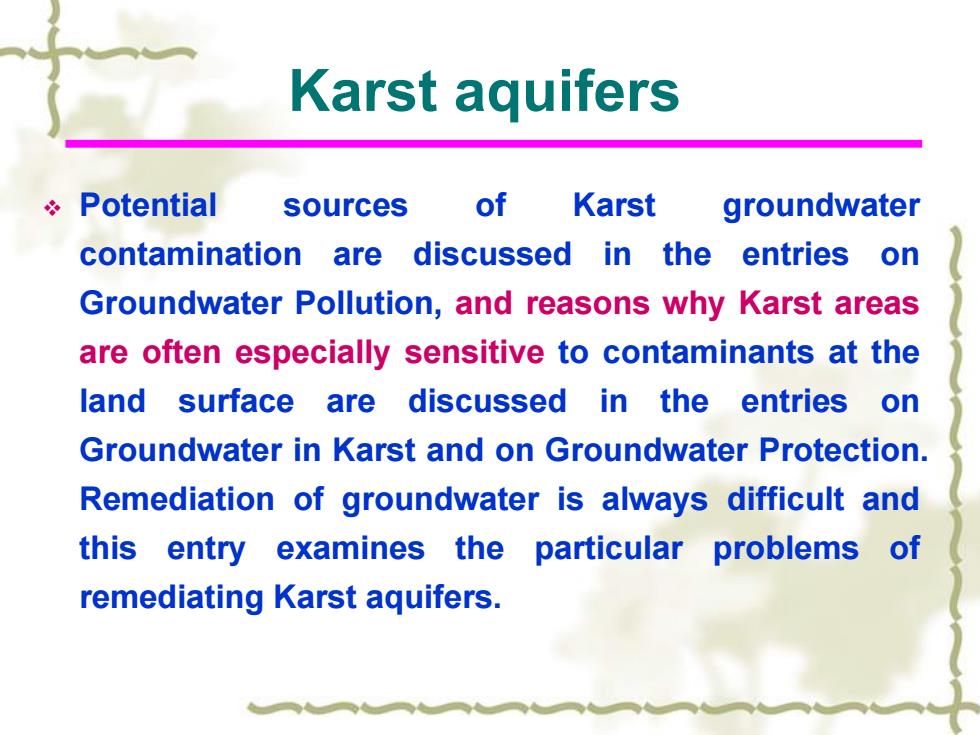
Karst aquifers Potential sources of Karst groundwater contamination are discussed in the entries on Groundwater Pollution,and reasons why Karst areas are often especially sensitive to contaminants at the land surface are discussed in the entries on Groundwater in Karst and on Groundwater Protection. Remediation of groundwater is always difficult and this entry examines the particular problems of remediating Karst aquifers
Karst aquifers Potential sources of Karst groundwater contamination are discussed in the entries on Groundwater Pollution, and reasons why Karst areas are often especially sensitive to contaminants at the land surface are discussed in the entries on Groundwater in Karst and on Groundwater Protection. Remediation of groundwater is always difficult and this entry examines the particular problems of remediating Karst aquifers
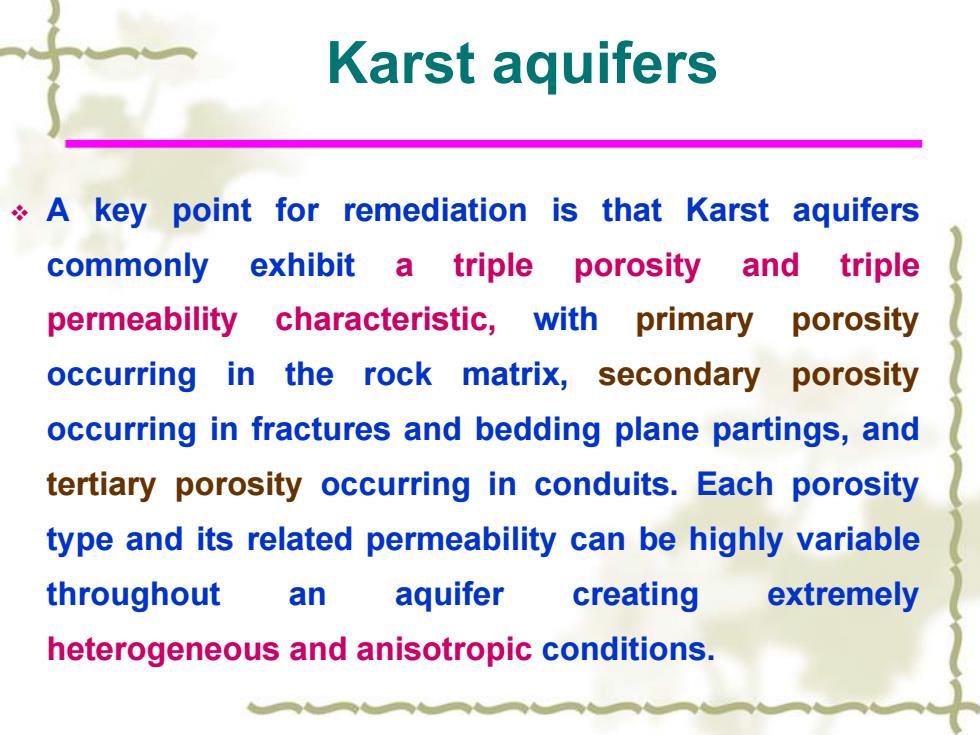
Karst aquifers A key point for remediation is that Karst aquifers commonly exhibit a triple porosity and triple permeability characteristic,with primary porosity occurring in the rock matrix,secondary porosity occurring in fractures and bedding plane partings,and tertiary porosity occurring in conduits.Each porosity type and its related permeability can be highly variable throughout an aquifer creating extremely heterogeneous and anisotropic conditions
Karst aquifers A key point for remediation is that Karst aquifers commonly exhibit a triple porosity and triple permeability characteristic, with primary porosity occurring in the rock matrix, secondary porosity occurring in fractures and bedding plane partings, and tertiary porosity occurring in conduits. Each porosity type and its related permeability can be highly variable throughout an aquifer creating extremely heterogeneous and anisotropic conditions
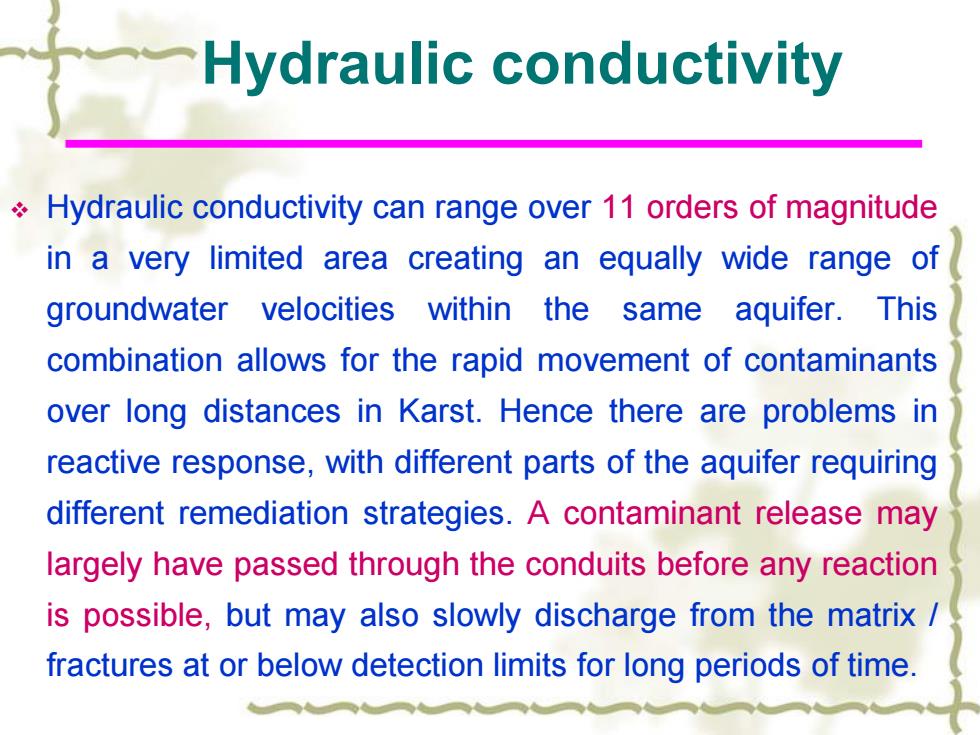
Hydraulic conductivity Hydraulic conductivity can range over 11 orders of magnitude in a very limited area creating an equally wide range of groundwater velocities within the same aquifer.This combination allows for the rapid movement of contaminants over long distances in Karst.Hence there are problems in reactive response,with different parts of the aquifer requiring different remediation strategies.A contaminant release may largely have passed through the conduits before any reaction is possible,but may also slowly discharge from the matrix fractures at or below detection limits for long periods of time
Hydraulic conductivity can range over 11 orders of magnitude in a very limited area creating an equally wide range of groundwater velocities within the same aquifer. This combination allows for the rapid movement of contaminants over long distances in Karst. Hence there are problems in reactive response, with different parts of the aquifer requiring different remediation strategies. A contaminant release may largely have passed through the conduits before any reaction is possible, but may also slowly discharge from the matrix / fractures at or below detection limits for long periods of time. Hydraulic conductivity
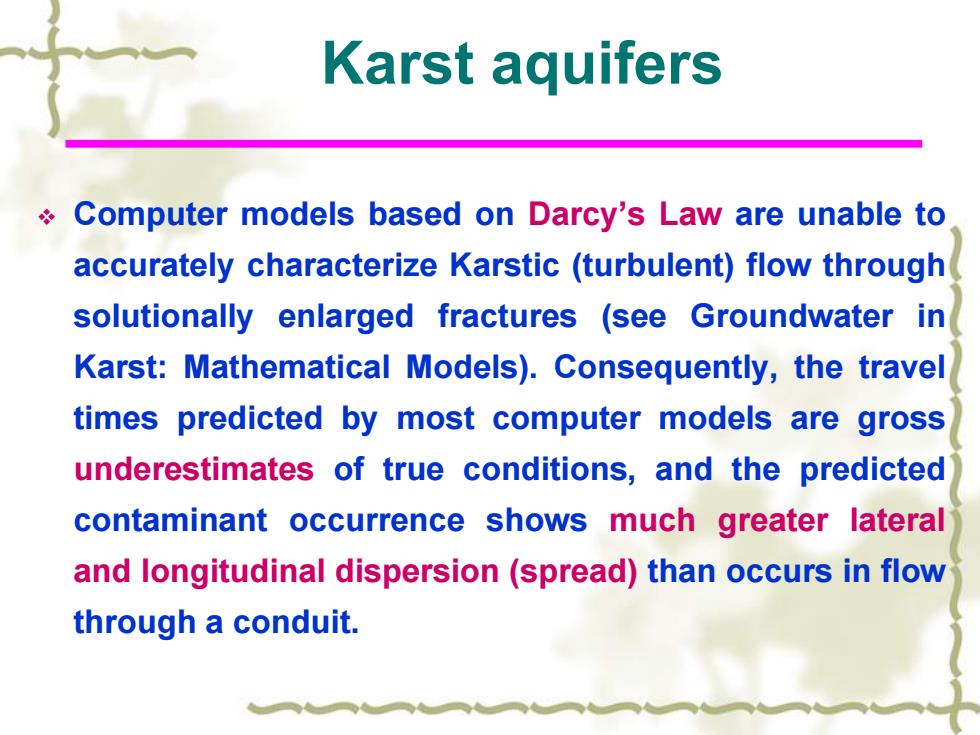
Karst aquifers Computer models based on Darcy's Law are unable to accurately characterize Karstic(turbulent)flow through solutionally enlarged fractures (see Groundwater in Karst:Mathematical Models).Consequently,the travel times predicted by most computer models are gross underestimates of true conditions,and the predicted contaminant occurrence shows much greater lateral and longitudinal dispersion(spread)than occurs in flow through a conduit
Computer models based on Darcy’s Law are unable to accurately characterize Karstic (turbulent) flow through solutionally enlarged fractures (see Groundwater in Karst: Mathematical Models). Consequently, the travel times predicted by most computer models are gross underestimates of true conditions, and the predicted contaminant occurrence shows much greater lateral and longitudinal dispersion (spread) than occurs in flow through a conduit. Karst aquifers
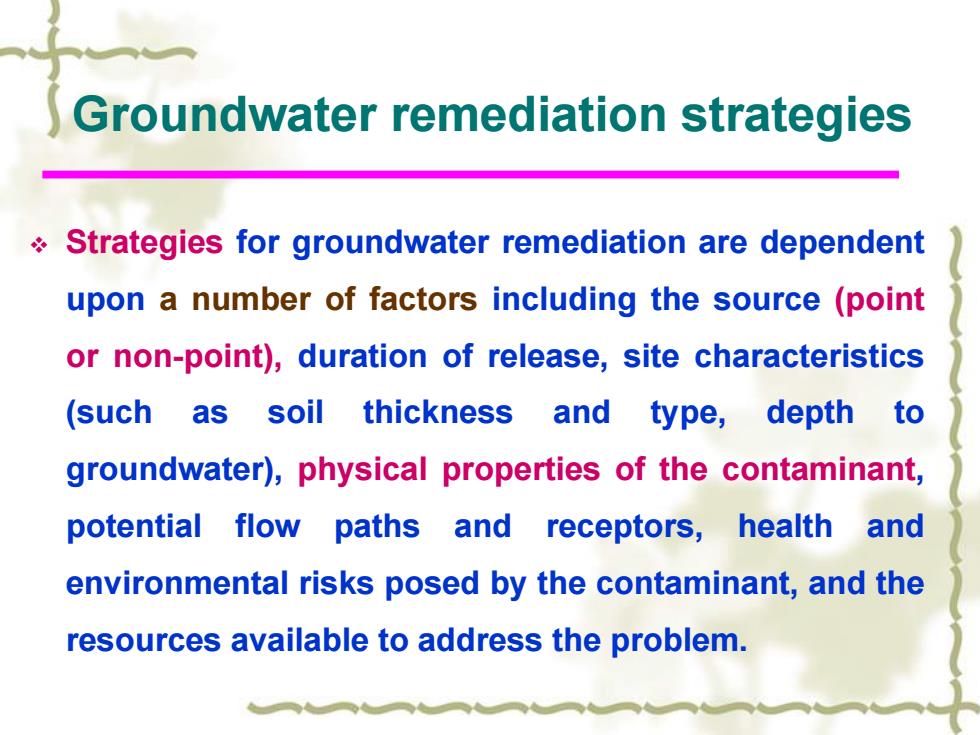
Groundwater remediation strategies Strategies for groundwater remediation are dependent upon a number of factors including the source(point or non-point),duration of release,site characteristics (such as soil thickness and type,depth to groundwater),physical properties of the contaminant, potential flow paths and receptors,health and environmental risks posed by the contaminant,and the resources available to address the problem
Groundwater remediation strategies Strategies for groundwater remediation are dependent upon a number of factors including the source (point or non-point), duration of release, site characteristics (such as soil thickness and type, depth to groundwater), physical properties of the contaminant, potential flow paths and receptors, health and environmental risks posed by the contaminant, and the resources available to address the problem